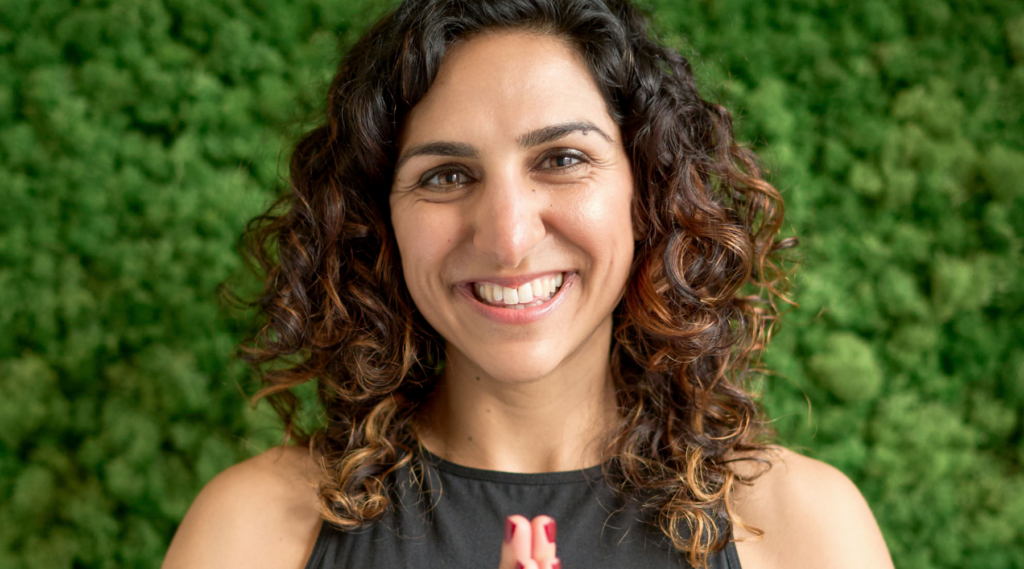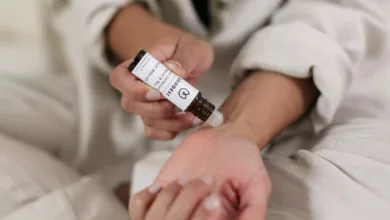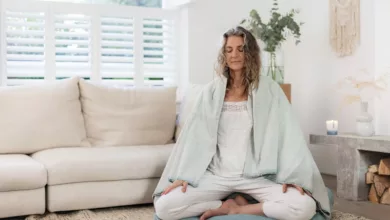Dr Rabia is a Gastroenterology registrar in London. She has a special interest in Neurogastroenterology and her research is examining the role of lifestyle factors in disorders of gut-brain interaction. She is also a practicing Yoga teacher & Cognitive Behavioural Hypnotherapist – offering mind-body tools for digestive health. Dr. Chang-Sun Park caught up with Dr Rabia to discover more about her incredible work.
Tell us about how you came to yoga?
I started yoga in my first year of university. I remember being transported from student halls (a fairly insular environment) into a wider community, into a really non-judgemental space. People from all different ages, races and backgrounds were there and we all moved in unison. The most powerful memory I formed that day still holds true today – the idea of self-intimacy. It was in those early days that I first noticed how the synergy between my own movement, breath and mental state brought me closer to myself.
Why yoga?
Yoga is a practice that requires quieting of the mind and dropping into the body – we notice what’s going on. In modern life, we’re separated from witnessing what’s going on because our energy is projected externally to achieve the things we want to achieve. When we get on our yoga mat and notice, it cultivates what I’ve come to understand as ‘interoceptive awareness’ – an awareness of your own bodily state from within, which recent research has shown contributes to our ability to self-regulate and this is precisely what I teach others to embody.
And your path in medicine – what is Neurogastroenterology?
In much the same way as yoga, I resonate with the synergy of how our gut works in tandem with the rest of our body. So I am now specialising in the area of Neurogastroenterology, which is all about the gut-brain connection. I love the physiology of the gut – over time, I’ve found it more and more fascinating. The nervous system connection is probably the most fascinating aspect to me and how we might empower ourselves to access this through our yoga practice.
How does the field of Gastroenterology look at yoga and mind-body practices?
I’d like to highlight the relationship and impact of yoga on the autonomic nervous system as it relates to the gut-brain axis. Our brains determine what is threatening, and therefore stressful. And the stress response is a two-way communication between the body and brain. You can get over and under-activity of that response. What determines the magnitude of the stress response is, on the one hand, what we perceive to be threatening (brain to body) but also a set of mechanisms that keep the parameters of our internal environment within the normal ranges necessary for survival (what we call homeostasis). So the body is also sending messages to the brain about those physiological parameters.
The cumulative burden of stress represents a kind of cost to the body – this has been called the ‘allostatic load’. We humans have a stress response which, in the here and now, is quite adaptive. For example, our heart rate and blood pressure rise with acute stress which helps us recover from a given stressful situation however, if we do not allow ourselves to recover sufficiently then this can lead to persistent high blood pressure and this is our ‘allostatic load’. Our understanding is that any perceived threat has the potential to exert a cumulative load on our body and so has to be shifted, in order for us to prevent the impact of long-term chronic stress.
Movement practices have a huge contribution to make to this shift. The processing of stress and trauma in the body. Research has shown that yoga shifts the allostatic load. It shifts us back to a balanced state and does so by slowing down the automatic movements in our body, breathing deeply and also through the use of sound (i.e. humming or mantra) – all of which are signals from the body to the brain that our physiology has permission to shift back to a place where we don’t feel under threat.
Can you tell us about any interesting yoga research you have come across?
A key study in (Link entfernt)compared yoga with the low FODMAP diet (one of the main dietary interventions for Irritable Bowel Syndrome, IBS) for 12 weeks, measuring outcomes at 24 weeks. A condition for the yoga was to focus on the body with a non-judgmental attitude (cycling back to the idea that interoceptive awareness seems to be something that can be proven in literature). There was a significant improvement in IBS symptom scores in both groups, with no significant difference between the interventions.
A (Link entfernt) in 2016 analysed 6 randomised controlled trials across 273 patients. They concluded that yoga is a feasible and safe complementary treatment. But they couldn’t draw specific conclusions as study designs are historically of poor quality, and yoga is so heterogeneous in the way that it’s delivered. Challenges in designing good quality studies can prevent us from validating the mechanisms by which yoga itself can reduce stress and hence gut symptoms.
Are patients on board with trying yoga to help their symptoms?
In order for an individual to accept that stress reduction techniques would be a useful complementary treatment option, they have to accept that they are stressed. This begins with an understanding that stress is not something that happens purely in your head but instead it rests within your entire nervous system. When no self-blame is attached and patients start to realise that stress is a whole-body response and felt in the entire nervous system, this is usually the beginning of a promising journey.
How do you go about recommending yoga for your patients?
The idea of yoga has certain connotations for certain people so I start by saying –
- you don’t have to be flexible to do yoga, you actually do yoga to become more flexible!
- use freely available online classes – access to yoga is unparalleled now, especially in the post-pandemic space.
- find a teacher that resonates with you whether at the fitness end or the spiritual end – that’s fine! You can start just a few minutes per day.
- buy a yoga mat or have a dedicated space that’s yours (for yoga). This provides an impetus to do it.
For those already practising yoga who perhaps don’t necessarily have symptoms – if they begin to notice any symptoms (not necessarily gut related), whether it’s a tension headache or eczema, I’d encourage people to experiment with slower floor-based practices with greater emphasis on breath and flow – what I perceive to be more nourishing for the nervous system.
If there was one practice you would recommend to patients to try, what would it be?
I’ve gravitated to recommending breathwork as a stand-alone practice. It’s the linchpin. It’s free, accessible, and has fewer barriers. You don’t need leggings, a mat or anything at all really. Any stress reduction practice has to be simple and easy for people to integrate. And it has to have a degree of validity. It’s indisputable that if you slow the breath and you exhale you influence vagal nerve activity i.e. the main nerve of the side of your nervous system responsible for relaxation. What is not known is how long you need to deep breathe for, in order to make changes in your baseline heart rate variability and baseline vagal tone; we don’t know all of those answers – yet. What we do know is that when we take a fully formed single deep breath or a few deep breaths, this will influence your cardiovascular tone and will shift your physiology even for a few seconds.
How does your personal practice look now?
Well, it’s a balance between my personal practice and teaching. With time, perhaps there is a sense that you have to achieve a certain level of asana or achieve a certain level of flexibility. That voice only becomes louder when you train as a teacher! Yet fluctuations are part of daily life. The moment we try to grasp more, it slips away from us. I’ve learnt to be okay with that. So, my current practice fluctuates in duration but is very consistent in its nature. I can vary between 5 and 90 minutes per day or miss a day altogether. But the nature of my practice? I’d describe this as being called to remember what it means to be in flow. When I am out of flow in my daily life – I know I need my yoga practice. When I anchor myself to the present moment I detach myself from the busyness of the thinking mind and drop into my body; and that has been a mechanism for presence that I can’t really do without.
How would you describe your teaching?
I am trained in Ashtanga and Vinyasa flow. I place an emphasis on flow and the way I teach is one of inquiry – noticing our internal state of being and what that means as a blueprint for how we interact with the world around us.
Has your relationship with yoga changed since being a teacher?
Yes! On the one hand, I’m having to articulate the feelings I have in my practice into what I want others to achieve – verbalising a commentary so as to inspire someone else to feel. This puts one in a vulnerable state; it can be enjoyable but also difficult. Then, on the other hand, there’s the constant process of letting go of the outcome – so I practice putting it out there into the space and then let it go. Knowing that you can’t necessarily inspire a feeling in someone else, they have to invoke it for themselves.
Tell us about your practice of Hypnotherapy
Gut-directed Hypnotherapy and CBT (cognitive behavioural therapy) are the two main areas in which management of IBS (Irritable Bowel Syndrome, the most common disorder of gut-brain interaction) have been approved in guidelines (both NICE and BSG). In order that yoga and pranayama could have more worth and be offered in a stress management package, I thought I have to offer the one thing that is currently watertight in evidence. So in 2018, I did a diploma in CBT and Hypnotherapy. Breathwork is part of both. And movement (asana) adds layers on top of that if someone is that way inclined; it becomes easy to integrate them. With Hypnotherapy, there are two challenges – stigma and lack of access around the country. CBT has better access, but it’s not necessarily gut-directed. More digital tools are arising which may help to increase access and I think that is great.
What is the reception for yoga like with your colleagues and peers? Have you found there to be any barriers?
They are reluctant to recommend activities without robust evidence which is understandable. I find my colleagues are open to yoga for general wellbeing, so they would put it in the ‘exercise/lifestyle’ umbrella which is complementary or adjunctive, and palatable. Yoga for gut health will take some time to catch on – because not all Gastroenterologists and other health professionals are familiar with the gut-brain axis. Research shows that disorders of the gut-brain axis (a.k.a. functional gut disorders) make up about a third of all GP consultations for gut issues and around a third of Gastroenterology outpatient consultations, but we don’t have the time to deliver a lifestyle-driven therapeutic consultation.
Why isn’t there more emphasis on Neurogastroenterology – given the large numbers of patients in need of this type of approach and understanding?
The burden of chronic disease, long term stress and stress-related conditions is increasing exponentially. The average doctor will have to give more credence and respect to this area with time.
On this note, a wider conversation about empowering patients to take ownership of their own health is needed – when the more serious conditions have been ruled out of course. We expect a solution when we go to the doctor. Even though we’ve rid ourselves of the paternalist mindset as clinicians as much as possible, there is still this relationship with a patient coming to the doctor with a problem and expecting a solution. But actually, the solution is within you – it’s hard for us to hand it back and say ‘your health is your priority’, but that’s where maybe yoga can come in. As doctors, we are in a privileged position to be able to recommend it and help people help themselves.
5 more minutes with Dr Rabia
- What time does your day start? 07:00
- Give us a short bio for yourself? Gastroenterology trainee doctor, researcher in the gut-brain connection, vinyasa flow yoga teacher (part time), teaching yoga for gut health, trained in Bristol, practicing since 2005, teaching since 2010.
- What is a typical day like for you? Wake up with my cat Mowgli, earl grey tea, personal yoga practice, PhD work, more earl grey tea, gym, evening clients for gut-directed hypnotherapy. Teaching yoga at the weekends mostly and retreats a few times per year.
- When did your Yoga/Wellbeing journey start? 2005.
- Where would be your dream place to lay down your mat? On a veranda overlooking the ocean, anywhere. The ocean waves soothe me, they taught me how to breathe and how to teach pranayama.
- Who / what inspires you on a daily basis and do you have a mantra or quote do you live by? My cat Mowgli inspires me, as he knows when to move and when to rest, he regulates his nervous system effortlessly! A quote I live by – “You can have it all, just not all at once” – Oprah Winfrey
- What is your most memorable yoga moment? On my last retreat during silent meditation one yogi fell asleep snoring and the whole group just broke silence, softly giggling until he woke up! Sometimes laughter is better than discipline.
- What is most important to you? To offer tools for managing digestive dis-ease and regulating our nervous system
- What is the best part about being a yoga teacher? Guiding someone back to themselves
- What is the worst part about being a yoga teacher? Not knowing if what others feel is as incredible as you feel teaching it! we have to relinquish control over the experience of our students and trust that they get whatever it is they need from class – nothing more or less.
- Can you recommend any podcasts, books to our readers podcasts? The Mark Groves podcast and the book Gut by Giulia Enders
- What change would you like to see in the health care system / yoga industry? A shift in understanding that yoga is not ‘alternative therapy’ it is essential self-care. That prevention is just as important as cure.
- Share with us any other projects that you have on the go? I offer CBT and gut-directed hypnotherapy for anyone suffering with gut health issues.
- What do you have coming up? Yoga for Digestive Health Day Retreat – Saturday May 28th 2022. Email doctor.rabia10@gmail.com to book or find out more.
- What would be your advice to someone just embarking on their wellbeing journey? Choose one thing, do it consistently and give yourself credit for moving towards your goal
Connect with Dr Rabia on her website: www.doctor-rabia.comor Instagram: @doctor_rabia
Read more from Dr.Rabia – 5 poses to Support Gut Health with Dr. Rabia
Aus der Feder von Yogamatters




